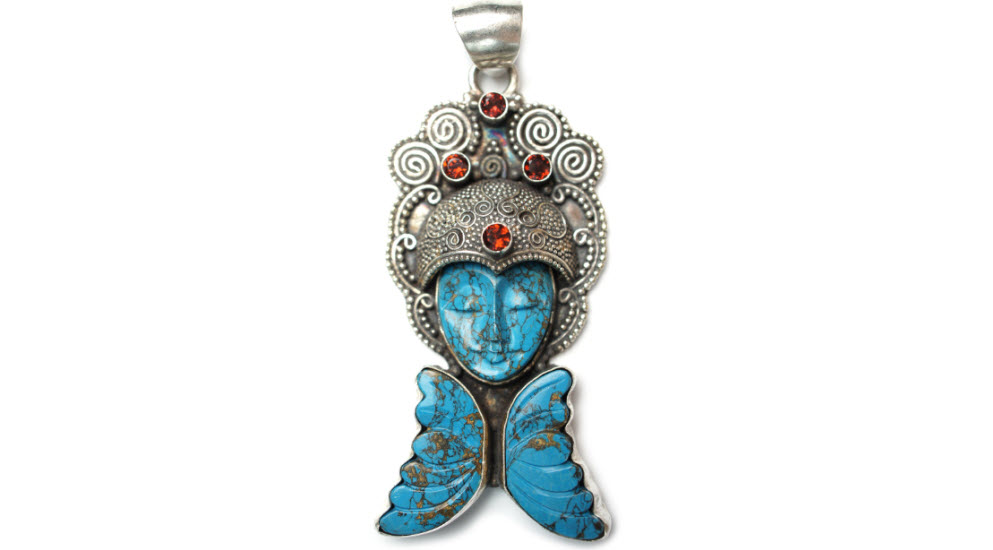In several cultures, December has been associated with the crystal Turquoise. From geologists to jewelers, miners to healers, ancient cultures to modern collectors, people from all over the world have long been captivated by Turquoise. This name originated in medieval Europe, where traders from Turkey introduced the blue-green gemstones as an exotic luxury. Although the stones were obtained from the mines in Persia (now Iran), medieval Europeans associated the stones with the Turkish traders who supplied them. They called them “turceis” or in later French, “turquois“. English speakers adopted the later French word and added an “e” to the end, “turquoise” while Spanish folks called the stone “turquesa“. Until the late 1800’s, it was known for centuries by the Navajos and other peoples in the Western Hemisphere by its Nahuatl name, “chalchihuitl”.
Scientifically, Turquoise is classified as a semiprecious opaque mineral composed of hydrated copper and aluminum phosphate. It has a triclinic crystaline structure and a hardness value of 5-6 on the Mohs scale. It is a secondary mineral derived from original, primary copper deposits that usually consist of chalchopyrite (a common yellow metalic mineral made up of sulfur, iron and copper) and pyrite (contains only sulfur and iron). In general, stones with more copper content appear more blue, while stones with more iron content are greener. Colour and character of its matirx will also be influenced by the other minerals found with it. Currently, the best quality Turquoise comes from Iran, Afghanistan, Australia, Tibet and Southwestern United States.
Robert Simmons, in his book entitled, The Book of Stones, relates these historical uses of Turquoise:
“Beads dating back to 5000 B.C. have been found in Iraq. The Egyptians were mining Turquoise in the Sinai in 3200 B.C. … About a thousand years ago, Native Americans began to mine and fashion Turquoise; the gem has been found in burial sites from Argentina to New Mexico. … To the native peoples of the American Southwest, this “sky stone” is an ancient talisman for health and happiness and for centuries it has been incorporated into both ceremonial and everyday jewelry, sculpture and pottery. In both Hindu and Persian beliefs, seeing a Turquoise and the New Moon at the same time would lead to good fortune, protection from evil and/or an increase in wealth. The Navajo used Turquoise to bring needed rain by throwing a stone into a river while praying to the rain god. Apaches thought Turquoise could enhance the accuracy of their weapons and the Zuni believed it could protect them from demons. In central Asia, the belief that Turquoise could keep riders from falling led to the use of Turquoise in decorating horse trappings.”
Other uses of Turquoise include using it to help dispel fear, especially if it grips the solar plexus and help maintain balance if used around the spleen and pancreas. In some Native American teachings, Turquoise is said to symbolize spirituality, the sky, the heavenly Father. It was regarded as a spiritual stone to help put people in touch with the divine and holy reality. It is considered by many as a stone for finding wholeness and truth and to aid in the communication and manifestation of these qualities. It is a stone of overall well-being and balanced mood and emotions. It teaches the wisdom of compassion and forgiveness.
Turquoise combines Water, Wind, Fire and Earth energies, making it a complete Storm element stone. According to crystal healer, Naisha Ahsian, “… Turquoise represents the wisdom that comes from all of life’s experiences. It is an ancient Grandfather ally, counseling one that all experiences are valid and that mistakes are simply another experience. …. Turquoise is a stone of self-forgiveness, self-acceptance and the release of useless regrets. It encourages one to honour oneself as a creation and a tool of the Divine.”
As you take time this month to reflect and revise your dreams and plans, use the gifts of Turquoise to help set the course for a New Year meant to bring you abundance on all levels, loving kindness in all your relations (including you with you!), extreme joy and steady confidence in all you do. You deserve nothing less!
Did you know ……
- December’s message: To endure; to die; to be reborn
- December’s activities: Introspection and renewal
- Universal event at this time of year: The revitalizing of the waters. Until Winter Solstice at the end of the month, night continues to increase and dominate. From that moment onward, we celebrate the Birth of the Light
- Lights of all kinds are important during these darkest days as they hold the promise of the Light to come; holiday lights, candles, fires, stars, crystals and twinkling things are used to remind us that within the darkest days, there is Light
- And where there is Light, there is Hope

